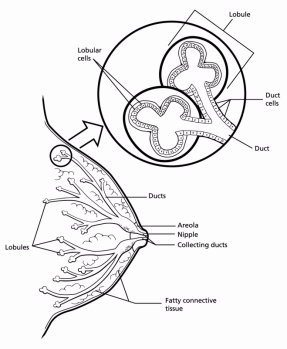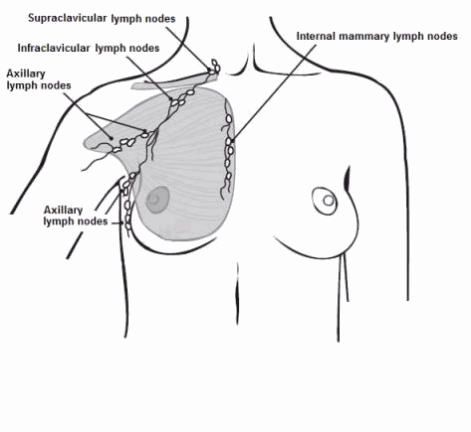What is Breast Cancer?
Breast cancer is a malignant tumor that starts in the cells of the breast. A malignant tumor is a group of cancer cells that can grow into (invade) surrounding tissues or spread (metastasize) to distant areas of the body. The disease occurs almost entirely in women, but men can get it, too.
The normal breast
To understand breast cancer, it helps to have some basic knowledge about the normal structure of the breasts, shown in the diagram below.
The female breast is made up mainly of lobules (milk-producing glands), ducts (tiny tubes that carry the milk from the lobules to the nipple), and stroma (fatty tissue and connective tissue surrounding the ducts and lobules, blood vessels, and lymphatic vessels).

Most breast cancers begin in the cells that line the ducts (ductal cancers). Some begin in the cells that line the lobules (lobular cancers), while a small number start in other tissues.
The lymph (lymphatic) system of the breast
The lymph system is important to understand because it is one way breast cancers can spread. This system has several parts.
Lymph nodes are small, bean-shaped collections of immune system cells (cells that are important in fighting infections) that are connected by lymphatic vessels. Lymphatic vessels are like small veins, except that they carry a clear fluid called lymph (instead of blood) away from the breast. Lymph contains tissue fluid and waste products, as well as immune system cells. Breast cancer cells can enter lymphatic vessels and begin to grow in lymph nodes.
Most lymphatic vessels in the breast connect to lymph nodes under the arm (axillary nodes). Some lymphatic vessels connect to lymph nodes inside the chest (internal mammary nodes) and those either above or below the collarbone (supraclavicular or infraclavicular nodes).

If the cancer cells have spread to lymph nodes, there is a higher chance that the cells could have also gotten into the bloodstream and spread (metastasized) to other sites in the body. The more lymph nodes with breast cancer cells, the more likely it is that the cancer may be found in other organs as well. Because of this, finding cancer in one or more lymph nodes often affects the treatment plan. Still, not all women with cancer cells in their lymph nodes develop metastases, and some women can have no cancer cells in their lymph nodes and later develop metastases.
Benign breast lumps
Most breast lumps are not cancerous (benign). Still, some may need to be biopsied (sampled and viewed under a microscope) to prove they are not cancer.
Fibrosis and cysts
Most lumps turn out to be caused by fibrosis and/or cysts, benign changes in the breast tissue that happen in many women at some time in their lives. (This is sometimes called fibrocystic changes and used to be called fibrocystic disease.) Fibrosis is the formation of scar-like (fibrous) tissue, and cysts are fluid-filled sacs. These conditions are most often diagnosed by a doctor based on symptoms, such as breast lumps, swelling, and tenderness or pain. These symptoms tend to be worse just before a woman’s menstrual period is about to begin. Her breasts may feel lumpy and, sometimes, she may notice a clear or slightly cloudy nipple discharge.
Fibroadenomas and intraductal papillomas
Benign breast tumors such as fibroadenomas or intraductal papillomas are abnormal growths, but they are not cancerous and do not spread outside the breast to other organs. They are not life threatening.
Still, some benign breast conditions are important because women with these conditions have a higher risk of developing breast cancer.
General breast cancer terms
Here are some of the key words used to describe breast cancer.
Carcinoma
This is a term used to describe a cancer that begins in the lining layer (epithelial cells) of organs like the breast. Nearly all breast cancers are carcinomas (either ductal carcinomas or lobular carcinomas).
Adenocarcinoma
An adenocarcinoma is a type of carcinoma that starts in glandular tissue (tissue that makes and secretes a substance). The ducts and lobules of the breast are glandular tissues (they make breast milk), so cancers starting in these areas are often called adenocarcinomas.
Carcinoma in situ
This term is used for an early stage of cancer, when it is confined to the layer of cells where it began. In breast cancer, in situ means that the cancer cells remain confined to ducts (ductal carcinoma in situ). The cells have not grown into (invaded) deeper tissues in the breast or spread to other organs in the body. Ductal carcinoma in situ of the breast is sometimes referred to as non-invasive or pre-invasive breast cancer because it might develop into an invasive breast cancer if left untreated.
When cancer cells are confined to the lobules it is called lobular carcinoma in situ. This is not actually a true cancer or pre-cancer.
Invasive (infiltrating) carcinoma
An invasive cancer is one that has already grown beyond the layer of cells where it started (as opposed to carcinoma in situ). Most breast cancers are invasive carcinomas—either invasive ductal carcinoma or invasive lobular carcinoma.
Sarcoma
Sarcomas are cancers that start in connective tissues such as muscle tissue, fat tissue, or blood vessels. Sarcomas of the breast are rare.
(Source of information: www.cancer.org)
